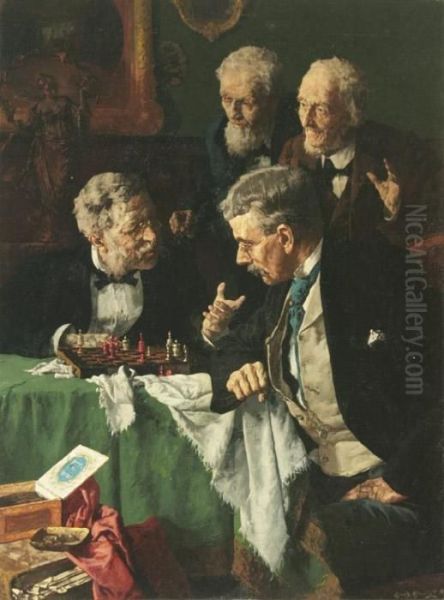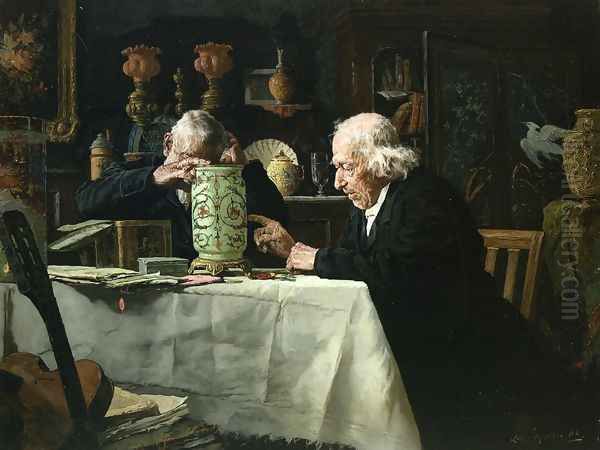Louis Charles Moeller stands as a significant figure in late 19th and early 20th-century American art. Born in New York City in 1855, he dedicated his artistic career to capturing intimate moments, primarily focusing on the lives of elderly gentlemen. His meticulous technique and keen observation earned him considerable acclaim during his lifetime, which extended until his passing in 1930. Moeller's work offers a window into the quiet dignity and contemplative activities of a specific social stratum of his era.
Though details about his earliest training are somewhat sparse, it is believed that Moeller may have received initial instruction from his father, Charles Moeller, who worked as a decorative painter in New York. This familial connection to the arts likely provided a foundational environment for the young Moeller's burgeoning talent. His formal artistic education began in his native city, where he enrolled at the prestigious National Academy of Design, an institution central to the development of many American artists.
European Training and Influences
Seeking to further refine his skills and broaden his artistic horizons, Moeller, like many ambitious American artists of his generation, traveled to Europe. In October 1873, he arrived in Munich, Germany, a major center for academic art training. He enrolled at the Royal Academy, where he studied for six years under the tutelage of Wilhelm von Diez, a respected painter known for his historical and genre scenes. The rigorous training of the Munich School emphasized strong draftsmanship, tonal accuracy, and a dark, rich palette, elements that would become visible in Moeller's later work.

During his time in Munich, Moeller also sought guidance from Frank Duveneck, an influential American painter who had also studied at the Royal Academy and became a mentor figure for many younger American artists studying abroad, often referred to as the "Duveneck Boys." Moeller frequently sought Duveneck's advice and critiques, absorbing aspects of his bolder brushwork and realistic approach. This period exposed Moeller to various European artistic currents, and sources suggest potential influences from German painters like the symbolist Arnold Böcklin and the classicist Hans von Marées, although Moeller's own path would remain firmly rooted in realism. Other notable American artists like William Merritt Chase and Walter Shirlaw also spent formative years studying in Munich around this time, contributing to a vibrant exchange of ideas.
Return to New York and Early Success
Upon returning to the United States, Moeller established himself in New York City and began to build his professional career. He started exhibiting his work, making his debut at the National Academy of Design in 1883. His meticulous style and chosen subject matter quickly found favor. A significant early milestone occurred in 1884 when his painting Puzzled (the current location of which is unknown) won the prestigious First Hallgarten Prize at the National Academy's annual exhibition. This award, intended to encourage younger artists, brought Moeller considerable recognition.
The same year, 1884, Moeller was elected an Associate member of the National Academy of Design (ANA), a significant honor confirming his rising status within the American art establishment. He continued to exhibit regularly at the Academy throughout the 1880s and 1890s, becoming a familiar and respected presence. His dedication and the consistent quality of his work led to his election as a full Academician (NA) in 1894, the highest rank offered by the institution, placing him alongside prominent figures in American art. Figures like Frederick Dielman, another artist active at the NAD, were part of this institutional landscape.
Artistic Style and Characteristic Subjects
Louis Charles Moeller developed a distinctive artistic style characterized by meticulous realism and careful execution. His paintings are known for their fine draftsmanship, precise rendering of details, and an accurate depiction of color, texture, and form. He possessed a remarkable ability to capture the play of light and shadow, adding depth and atmosphere to his intimate interior scenes. His technique often involved careful preliminary sketches and a deliberate application of paint, resulting in highly finished surfaces.
Moeller became particularly renowned for his focus on a specific subject: small groups of elderly, distinguished gentlemen, often depicted in comfortable, slightly cluttered Victorian interiors. These men are typically shown engaged in quiet, contemplative activities – reading newspapers, examining documents, discussing matters seriously, playing chess, or engaging in a game of cards. He avoided grand historical or mythological themes, preferring instead the subtle narratives found in these everyday moments.

His paintings often possess a quiet dignity and a palpable sense of concentration. The figures are rendered with psychological insight, their postures and expressions conveying personality and the nature of their interactions. While not overtly sentimental, his work treats his elderly subjects with respect and empathy. This focus on specific character types and interior genre scenes aligns him broadly with other American genre painters like Eastman Johnson, though Moeller's scale was generally smaller and his focus narrower, or J.G. Brown, who famously depicted New York street urchins, showcasing a different facet of urban life.
Notable Works and Critical Reception
Among Moeller's representative works, The Card Game exemplifies his typical subject matter and style. This oil painting, measuring 8¼ by 10¼ inches and signed "Louis Moeller NA," captures a moment of focused leisure among elderly gentlemen. Although currently held in a private collection and lacking a public exhibition history, works like this cemented his reputation. Another known painting is Crons, depicting two elderly men engrossed in a game of chess while a third figure looks on, showcasing his recurring interest in games as a vehicle for depicting concentration and social interaction. The specific collection details for Crons are not readily available from the source material.
During the late 19th century, Moeller's work was highly regarded by both critics and collectors. His detailed realism and the relatable, albeit specific, nature of his subjects appealed to the tastes of the time. Prominent collectors like Thomas B. Clarke acquired his paintings, signifying his acceptance within the upper echelons of the art market. His work was seen as embodying solid craftsmanship and a respectable, narrative form of art.
Critics praised the technical skill evident in his paintings. The sculptor F. Wellington Ruckstuhl, for instance, commented on the dramatic quality inherent in Moeller's compositions, noting his ability to convey narrative and emotional tension even within quiet scenes. This suggests that Moeller, despite the seemingly mundane subject matter, imbued his work with a subtle theatricality through careful arrangement of figures, objects, and light. His style offered a contrast to the broader, more impressionistic brushwork of contemporaries like John Singer Sargent or the rugged outdoor scenes of Winslow Homer, carving out a distinct niche for himself.
Recognition and Legacy
Moeller's success was not limited to the National Academy of Design. He received further accolades at major international expositions, events that showcased artistic achievements from around the world. Records indicate he was awarded medals at the Paris Exposition of 1889, the World's Columbian Exposition held in Chicago in 1893, and the Pan-American Exposition in Buffalo, New York, in 1902. Such awards underscore the high esteem in which his work was held both nationally and internationally during his active years.

His legacy is preserved not only through his numerous paintings in private hands but also through representation in public collections. Notably, the Metropolitan Museum of Art in New York holds an example of his work, ensuring its accessibility for future generations and confirming his place within the canon of American art history. While firmly rooted in the realist tradition, perhaps sharing some sensibilities with the unflinching observation found in works by Thomas Eakins, Moeller's contribution lies in his focused exploration of a particular social milieu.
Interestingly, despite his clear stylistic affinities and his active participation in the institutional art world of his time (particularly the National Academy of Design), the available source material does not explicitly link Louis Charles Moeller to any specific named art movements or formal artists' groups beyond the Academy itself. His career seems characterized by a consistent dedication to his chosen style and subject matter rather than alignment with broader manifestos or collective identities.
Later Life
Louis Charles Moeller continued to work through the early decades of the 20th century, maintaining his commitment to the detailed genre scenes that had defined his career. He passed away in 1930 at the age of 75. While the exact location of his death is not specified in the consulted sources, his life began and was largely centered professionally in New York City.
In conclusion, Louis Charles Moeller was a highly skilled American painter whose career spanned a period of significant change in the art world. He remained steadfastly committed to a meticulous form of realism, specializing in intimate genre scenes depicting elderly gentlemen. Trained in both New York and Munich, he absorbed academic principles while developing a distinct personal style. Recognized with numerous awards and collected by prominent patrons, Moeller achieved considerable success during his lifetime. His work provides valuable insight into the quiet interiors and social interactions of a segment of American society in the late 19th and early 20th centuries, rendered with exceptional technical proficiency and subtle psychological depth.